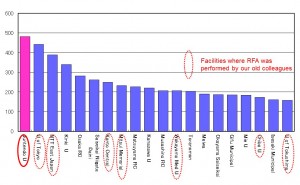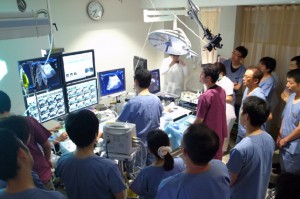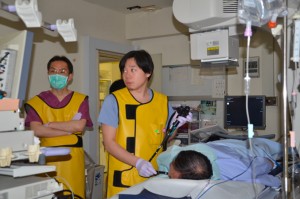Juntendo Research Profiles – Division of Diagnostic Imaging and Interventional Oncology
Division of Diagnostic Imaging and Interventional Oncology
Director: Shuichiro Shiina (Professor)
The ability to see disease inside a patient’s body is crucial for accurate diagnosis and treatment. Our division is responsible for providing patients with state-of-the-art diagnostic imaging and minimally invasive therapy in hepato-biliary-pancreatic diseases. Our vision is a commitment to world-class patient care, research and education in hepato-biliary-pancreatic areas.
Research Topics
Image-Guided Percutaneous Ablation
Shuichiro Shiina (Professor) and others are devoted to image-guided percutaneous ablation therapies. As of 2015, Prof. Shiina has performed over 9,500 radiofrequency ablation for primary or metastatic liver tumors. Over 10-year experience clearly shows that radiofrequency ablation is potentially curative, minimally invasive, and easily repeatable for recurrence. Sophisticated RFA would be superior to surgery in the treatment of small- and middle-sized liver tumors.
Juntendo University is the highest volume center of RFA in Japan (Figure 1), which obliges us to teach technical aspects of RFA skills to doctors in other institutions and standardize the RFA procedure. We hold Radiofrequency Ablation (RFA) Training Program four times a year (Figure 2).
The program has comprehensive lectures, live demonstration and case study. The content of the lectures are current status of RFA, RFA devices, ultrasonography, indications and complications of RFA, nursing practice in RFA, RFA for metastatic liver cancer, and image assessment of cases before and after RFA (Figure 2).
The live demonstration includes presentation of three cases on which we would perform RFA on the next day, and planning ultrasound examinations conducted by participants on the first day. On the second day, we perform RFA on the three cases, using artificial ascites technique, contrast-enhanced ultrasound guidance, and fusion imaging method (Figure 3).
In the case study, around 10 difficult to ablate cases from participants’ hospitals and ours are presented and discussed.
We plan to have an international version of the program in which we would accept foreign doctors in the near future.
We will organize an APASL (Asian Pacific Association for the Study of the Liver) Single Topic Conference on HCC (hepatocellular carcinoma) in 2017 (Figure 4).
Figure-1 Top 20 RFA institutes in Japan in 2013
Figure-2 A comprehensive lecture at Radiofrequency Ablation (RFA) Training Program
Figure-3 A live demonstration at Radiofrequency Ablation (RFA) Training Program
Figure-4 APASL (Asian Pacific Association for the Study of the Liver) Single Topic Conference on HCC (hepatocellular carcinoma) in 2017
Diagnostic Imaging and Management of Pancreato-Biliary Disease
Jin Kan Sai (Senior Associate Professor) and others have investigated the diagnostic imaging and management of pancreato-biliary disease (Figure 5). Our current research interests are as follows:
- Clinicopathological findings of gallbladder cancer and extrahepatic bile duct cancer at an early stage
- Early diagnosis of pancreatic cancer
- Pre-cancerous lesion of the gallbladder and pancreas
- Early diagnosis and management of chronic pancreatitis
- Pancreatoscopy
- Cholangioscopy
- Contrast enhanced endoscopic ultrasonography
- Intraductal ultrasonography
- Pancreatic duct lavage cytology
- Endoscopic drainage of the gallbladder, bile duct and pancreatic duct
Figure-5 A scene of endoscopic intervention
Minimally Invasive Angiographic Procedures
Ryo Kanazawa (Assistant Professor) and others offer minimally invasive angiographic procedures, especially transcatheter arterial chemoembolization (TACE) and arterial infusion chemotherapy for hepatocellular carcinoma. TACE has been shown to increase survival in patients with intermediate stage HCC. TACE may also be used to downstage HCC in patients who far exceed the conventional indications of RFA.
Publications
- Shiina S, Teratani T, Obi S, Sato S, Tateishi R, Fujishima T, Ishikawa T, Koike Y, Yoshida H, Kawabe T, Omata M. A randomized controlled trial of radiofrequency ablation with ethanol injection for small hepatocellular carcinoma. Gastroenterology. 2005; 129:122-30.
- Shiina S, Tateishi R, Arano T, Uchino K, Enooku K, Nakagawa H, Asaoka Y, Sato T, Masuzaki R, Kondo Y, Goto T, Yoshida H, Omata M, Koike K. Radiofrequency ablation for hepatocellular carcinoma: 10-year outcome and prognostic factors. Am J Gastroenterol 2012; 107:569-77.
- Shiina S, Tateishi R, Imamura M, Teratani T, Koike Y, Sato S, Obi S, Kanai F, Kato N, Yoshida H, Omata M, Koike K. Percutaneous ethanol injection for hepatocellular carcinoma: 20-year outcome and prognostic factors. Liver International 2012; 32:1434-42.
- Sai JK, Nobukawa B, Matsumura Y, et al. Pancreatic duct lavage cytology with the cell block method for discriminating benign and malignant branch-duct type intraductal papillary mucinous neoplasm. Gastrointest Endosc 2013;77:726-35
- Suzuki M, Sai JK, Shimizu T. Acute pancreatitis in children and adolescent. World J Gastrointest Pathophysiol 2014; 5:416-426Should you wish for further information, please do not hesitate to contact us.
Should you wish for further information, please do not hesitate to contact us.




